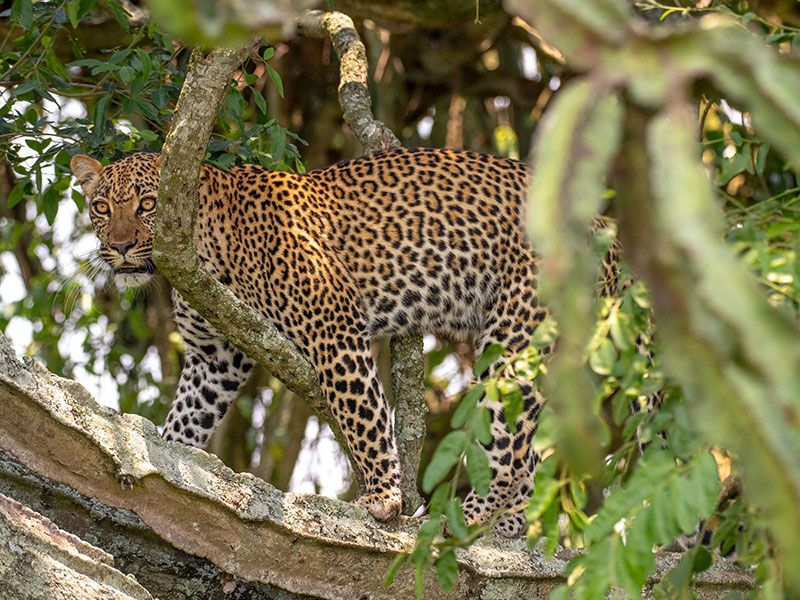- EXPERT'S HELP
- +256789210067
- +256200955001
- info@kenlinktours.com

Best Uganda Tours in 2024
October 21, 2023
Where to see birds in Uganda
October 23, 2023Leopards in Uganda, we consider them one of the big five mammals, and they are so isolated animals that they don’t like staying in groups. It means they live a solitary life. It’s estimated that around 300-500 leopards in Uganda. However, it’s important to note that these numbers are approximate and can change due to various factors, including habitat loss, poaching, and human-wildlife conflicts.
Facts about Leopards.
Certainly! Leopards are fascinating big cats known for their striking appearance and elusive behavior. Here are some interesting facts about leopards:
- Physical Characteristics: Leopards are easily recognizable by their golden-yellow fur with black rosettes (spot patterns). The rosettes are smaller and closer together in East African leopards, while the larger rosettes characterize the African and Indian leopard subspecies.
- Habitat: Leopards are highly adaptable and can be found in a wide range of habitats, including grasslands, savannas, forests, mountains, and deserts. They have one of the largest distributions of any wild cat species.
- Solitary Behavior: Leopards are solitary animals and are known for their independence. They are territorial and mark their territories with scent markings to communicate with other leopards.
- Nocturnal Predators: Leopards are primarily nocturnal, which means they are most active during the night. Their excellent night vision helps them hunt in low light conditions.
- Powerful Predators: Leopards are powerful and agile hunters capable of taking down prey larger than themselves. They have a strong bite and can carry their kills into trees to avoid scavengers.
- Variety in Diet: Leopards have a diverse diet, feeding on a wide range of animals, including impalas, gazelles, rodents, and even small mammals. They are opportunistic predators.
- Incredible Strength: Leopards are known for their incredible strength and can drag their prey up into trees, sometimes even heavier than themselves.
- Cubs and Maternity: Female leopards give birth to a litter of cubs (usually 2-3) and are responsible for raising them alone. Cubs stay with their mother for about 18-24 months before becoming independent.
- Camouflage: Their spotted coat serves as effective camouflage, helping them blend into their surroundings while stalking prey.
- Endangered Status: Leopards are classified as “Vulnerable” by the International Union for Conservation of Nature (IUCN). They face threats from habitat loss, poaching, and conflict with humans.
- Communication: Leopards communicate through vocalizations such as roars, growls, and purrs. These sounds play a role in territory marking and mating.
- Speed and Agility: Leopards are known for their speed and agility. They can run at speeds of up to 36 miles per hour (58 kilometers per hour) and can leap over 20 feet (6 meters) horizontally and 10 feet (3 meters) vertically.

Here are some of the national parks you can get the leopard from.
- Queen Elizabeth National Park: This park in western Uganda is known for its diverse wildlife, including leopards. The Ishasha sector, in particular, is famous for its tree-climbing lions and leopards. Game drives in this area offer a good chance to spot these elusive cats.
- Murchison Falls National Park: Located in northern Uganda, Murchison Falls National Park is home to leopards along with other big cats. Game drives along the park’s tracks and riverbanks increase your chances of leopard sightings.
- Kidepo Valley National Park: Situated in the remote northeast, Kidepo Valley National Park is one of Uganda’s hidden gems. Leopards can be found in the savannah and rocky outcrops of this park. Game drives and guided safaris are popular ways to encounter these cats.
- Bwindi Impenetrable National Park: While Bwindi is famous for its mountain gorillas, it is also home to leopards. These leopards are less frequently spotted due to the dense forest, but guided forest walks and night game drives provide opportunities to catch a glimpse.
- Kibale National Park: Located in western Uganda, Kibale National Park is renowned for its chimpanzee tracking. Leopards are present in the park, and while not a primary attraction, you may encounter them during guided nature walks or nocturnal activities.






2 Comments
[…] skills and intimate knowledge of the park to seek out elusive species and hidden gems, such as leopard resting in the boughs of a tree or a pack of wild dogs on the hunt. Along the way, they share fascinating […]
[…] National Park can expect to encounter wildlife such as lions, elephants, buffaloes, hippos, leopards, and a wide variety of antelopes. The famous Kazinga Channel, which connects Lake Edward and Lake […]